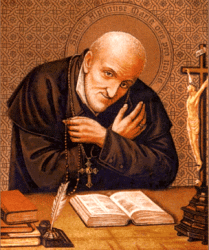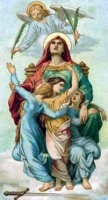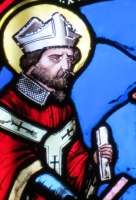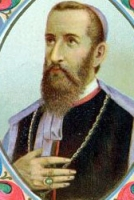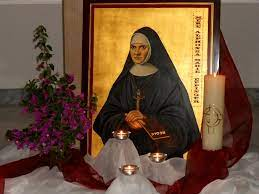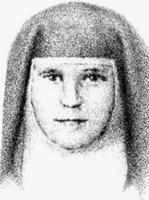Saint Alphonsus Maria de Liguori
புனித அல்போன்ஸ் மரிய லிகோரி (St. Alphonsus Liguori)
ஆயர், மறைவல்லுநர் (Bishop and Doctor of the Church)
பாதுகாவல்: ஒப்புரவு தரும் அருள்தந்தையர் (Confessor), நல்லொழுக்க நீதி சார் இறையியலர்(Moral theologians)
பிறப்பு
27 செப்டம்பர் 1696
நேயாபல், இத்தாலி (Marinella bei Neapel, Italien)
இறப்பு
01 ஆகஸ்டு 1787
நேயாபல்(Nocera dei Pagani bei Neapel)
முத்திபேறுபட்டம்: 1816, திருத்தந்தை 7ஆம் பயஸ்
புனிதர்பட்டம்: 29 மே 1839, திருத்தந்தை 16 ஆம் கிரகோரி
ஆயர்பட்டம்: 1762, திருத்தந்தை 13 ஆம் கிளமெண்ட், வடக்கு நேயாபல் (Diocese S.Agatha dei Goti im Norden von Neapel)
இவர் உரோமன் சட்டத்திலும், திருச்சபை சட்டத்திலும் பட்டம் பெற்றார். மறைபரப்பு பணியில் ஆர்வம் கொண்டிருந்தார். இதனால் குருத்துவ வாழ்விற்கு தன்னை ஈடுபடுத்தினார். இவரின் வாழ்வு மக்களிடையே பல தாக்கத்தை ஏற்படுத்தியது. மிக சிறப்பான இவரின் மறைபரப்புப் பணியால், நேப்பிள்ஸ் நகர் ஆயராக தேர்ந்தெடுக்கப்பட்டார். பின்னர் "புனித இரட்சகர்" என்ற பெயரில் ஒரு துறவற சபையை நிறுவினார். மக்களிடையே கிறிஸ்துவ வாழ்வை வளப்படுத்த, சிறப்பான மறையுரையை ஆற்றினார். ஒழுக்க நெறி சார்ந்த இறையியல் நூல்கள் பல எழுதினார். இவர் தலைசிறந்த இறையியல் ஆசிரியராகவும் பணியாற்றினார். பின்னர் ஆயர் பொறுப்பிலிருந்து விலகினார். தான் தொடங்கிய துறவற சபையில் வாழ்ந்தார். மரியன்னையின்மீது பக்தி, திவ்ய நற்கருணை சந்திப்பு, சிலுவைப்பாதை செய்தல் இவைகளில் தன் சபையிலுள்ளவர்களை ஈடுபடுத்தினார். எவற்றின் மீதும் பற்றுக்கொள்ளக்கூடாது என்பதை வலியுறுத்தினார்.
இவர் பல பயணங்களை மேற்கொண்டு, நேப்பிள்ஸ் நாட்டில் சிறப்பான மறையுரையை ஆற்றி நன்மைகள் பல செய்தார், இவர் வயது முதிர்ந்தவராய் இருந்ததால் பார்வையிழந்து காணப்பட்டார். இதனால் சிலர் இவரை தவறான வழியில் நடத்தினர். எதிரிகளின் சூழ்ச்சியால், சில முக்கிய ஒப்பந்தங்களில் தெரியாமல், தவறாக கையொப்பமிட்டார். இதனால் இவரின் சபையில் பல பிளவுகள் உண்டானது. இதனால் அல்போன்ஸ் மனமுடைந்து, மிக வேதனை அடைந்தார். சில உறவுகளையும் இழந்தார். நோயினால் தாக்கப்பட்டு கொடுமையான வேதனையை அனுபவித்த அல்போன்ஸ் தனது 83 ஆம் வயதுவரை தன் சபையை சேர்ந்தவர்களாலேயே, ஒதுக்கி வைக்கப்பட்டார். இயேசுவின் பாடுகளை இடைவிடாமல் தனது இறுதி நாட்களில் அனுபவித்து இறைவனடி சேர்ந்தார்.
Also known as
Alfonso, Alfons, Alfontso, Alphonse, Alfonsu, Afonso
Profile
Born to the nobility, Alphonsus was a child prodigy; he became extremely well-educated, and received his doctorate in law from the University of Naples at age 16. He had his own legal practice by age 21, and was soon one of the leading lawyers in Naples, though he never attended court without having attended Mass first. He loved music, could play the harpsichord, and often attended the opera, though he frequently listened without bothering to watch the over-done staging. As he matured and learned more and more of the world, he liked it less and less, and finally felt a call to religious life. He declined an arranged marriage, studied theology, and was ordained at age 29.
Preacher and home missioner around Naples. Noted for his simple, clear, direct style of preaching, and his gentle, understanding way in the confessional. Writer on asceticism, theology, and history; master theologian. He was often opposed by Church officials for a perceived laxity toward sinners, and by government officials who opposed anything religious. Founded the Redemptoristines women's order in Scala in 1730. Founded the Congregation of the Most Holy Redeemer (Liguorians; Redemptorists) at Scala, Italy in 1732.
Appointed bishop of the diocese of Sant'Agata de' Goti, Italy by Pope Clement XIII in 1762. Worked to reform the clergy and revitalize the faithful in a diocese with a bad reputation. He was afflicted with severe rheumatism, and often could barely move or raise his chin from his chest. In 1775 he resigned his see due to ill health, and went into what he thought would be a prayerful retirement.
In 1777 the royal government threatened to disband his Redemptorists, claiming that they were covertly carrying on the work of the Jesuits, who had been suppressed in 1773. Calling on his knowledge of the Congregation, his background in thelogy, and his skills as a lawyer, Alphonsus defended the Redemptorists so well that they obtained the king's approval. However, by this point Alphonsus was nearly blind, and was tricked into giving his approval to a revised Rule for the Congregation, one that suited the king and the anti-clerical government. When Pope Pius VI saw the changes, he condemned it, and removed Alphonsus from his position as leader of the Order. This caused Alphonsus a crisis in confidence and faith that took years to overcome. However, by the time of his death he had returned to faith and peace.
Alphonsus vowed early to never to waste a moment of his life, and he lived that way for over 90 years. Declared a Doctor of the Church by Pope Pius IX in 1871.
When he was bishop, one of Alphonsus's priests led a worldly life, and resisted all attempts to change. He was summoned to Alphonsus, and at the entrance to the bishop's study he found a large crucifix laid on the threshold. When the priest hesitated to step in, Alphonsus quietly said, "Come along, and be sure to trample it underfoot. It would not be the first time you have placed Our Lord beneath your feet."
Born
27 September 1696 at Marianelli near Naples, Italy
Died
1 August 1787 at Nocera, Italy of natural causes
Canonized
26 May 1839 by Pope Gregory XVI
Patronage
• against arthritis
• against scrupulosity
• confessors (given on 26 February 1950 by Pope Pius XII)
• final perseverance
• moral theologians
• moralists (1950 by Pope Pius XII)
• scrupulous people
• theologians
• vocations
• Sisters of the Holy Redeemer
• diocese of Acerra, Italy, diocese of
• Agrigento, Italy
• Pagani, Italy
• Sant'Agata de' Goti, Italy
Martyrs of Nowogrodek
Also known as
• Martyrs of Novogrudok
• Nasaret-sostrene fra Nowogródek
• Nowogrodek Martyrs
• Sister Mary Stella and her Ten Companions
• Sisters of the Holy Family of Nazareth
Profile
A group of eleven Holy Family of Nazareth nuns who were murdered by the Nazi Gestapo in exchange for 120 condemned citizens of Nowogrodek, Belarus who were scheduled for revenge killings. They are –
• Adela Mardosewicz
• Anna Kukolowicz
• Eleonora Aniela Józwik
• Eugenia Mackiewicz
• Helena Cierpka
• Jadwiga Karolina Zak
• Józefa Chrobot
• Julia Rapiej
• Leokadia Matuszewska
• Paulina Borowik
• Weronika Narmontowicz
Died
• machine-gunned by firing squad on 1 August 1943 by the Gestapo about three miles outside Novogrudok (Nowogródek), Hrodzyenskaya voblasts', in Nazi occupied Belarus
• buried on the site of the execution in a common grave
• one of their surviving sisters, Maria Malgorzata Banas, located the grave on 19 March 1945 and tended to it until her death in 1966
• relics re-interred in a common sarcophagus in the chapel of the Novograd Farny Church (the Church of the Transfiguration, also known as Biala Fara or the White Church)
Beatified
5 March 2000 by Pope John Paul II in Rome, Italy
Feast of Saint Peter in Chains
Also known as
• Saint Peter ad Vincula
• San Pietro in Vincoli
• Liberation of Saint Peter
• Release of Saint Peter
• Deliverance of Saint Peter
About the Feast
The feast was originally kept in Rome, Italy to commemorate the dedication of the Church of Saint Peter on the Esquiline Hill built by Eudoxia Licinia in 442, and rebuilt by Adrian I in the 8th century. When the chains which Saint Peter had worn in prison, and from which he was freed by angelic intervention (see readings below) were later venerated there, the feast received its present name.
The date when these chains were brought from Jerusalem is disputed; some claim they were brought in 116 by travellers sent in search of them by Saint Balbina and her father Saint Quirinus, while others think Saint Eudoxia brought them in 439. Pope Saint Leo the Great united them to the chains with which Saint Peter had been fettered in the Mamertine Prison, forming a chain about two yards long which is preserved in a bronze safe and guarded by a special confraternity.
Patronage
• diocese of Annecy, France
• Donnas, Italy
Blessed Pierre-Lucien Claverie
Also known as
the bishop of the Muslims (he was called this by Muslim mourners at his funeral)
Profile
Born to a working class French family living in Algeria. At age 10, Pierre joined the scouts in a troop led by Dominicans, and became familiar with their spirituality. He attended college in Grenoble, France, and joined the Dominicans himself at the convent in Lille, France on 7 December 1958. He studied at a Dominican institute near Paris, France, and in 1962, after the Algerian war of independence, he returned to Algiers. There he served his mandatory time in the armed forces, but refused to bear arms. After his service, Pierre resumed his studies in France in September 1963, and was ordained a priest on 4 July 1965.
Father Pierre spent time learning Arabic and studying Islam, then returned to Algeria to help the people re-build their lives after the war. From 1973 to 1981 he ran an institute in Algiers for the study of classical Arabic and Islamic history; it was started as a way to prepare Christian missionaries for work in Islamic regions, but became a popular school for local Muslims who wanted to learn Arabic and their Islamic cultural history. Father Pierre worked for dialogue between Christians and Muslims, believing that communication and open religious discussion could lead to peace.
He was chosen bishop of Oran, Algeria on 25 May 1981. He built libraries, therapy centers for the handicapped, and schools, including ones for women. When the Algerian Civil War broke out in 1992, many of the Catholic clergy fled the country, but Father Pierre considered himself an Algerian as well as French, and stayed to work for peace and serve his flock. He died with his driver and friend Mohamed Bouchikhi in a bomb blast set by anti–Christian forces. Martyr.
Born
8 May 1938 in Algiers, Algeria
Died
• from a bomb explosion that destroyed the entrance to the chancery as he was entering the building on 1 August 1996 in Oran, Algeria
• seven people were convicted of the murders and sentenced to death on 23 March 1998; the Catholic Church of Algeria managed to get their sentences commuted
Venerated
26 January 2018 by Pope Francis (decree of martyrdom)
Holy Maccabees
Also known as
The Machabees
Profile
Jewish dynasty which began with the rebellion of Mathathias and his five sons against the Syrian king, Antiochus IV (168 BC) and ruled the fortunes of Israel until the advent of Herod the Great. Syrian attempts to force Greek paganism on the Jews, the profanation of the Temple at Jerusalem, and the massacre which followed, brought the nation to arms under Mathathias, a priest of the sons of Joarib. At the death of Mathathias, Judas Machabeus, his third son, drove the Syrians and Hellenists out of Jerusalem, rededicated the Temple, and began an offensive and defensive alliance with the Romans. Before the treaty was concluded, however, Judas, with 800 men, risked battle at Laisa with an overwhelming army of Syrians under Bacchides, and was slain. He was succeeded in command by his youngest brother, Jonathan (161 BC). Jonathan defeated Bacchides, revenged the death of his brother, and made peace with Alexander who had usurped the throne of Demetrius, the successor to Antiochus. A period of peace followed in which Jonathan ruled as high priest in Jerusalem, but Tryphon, who was plotting for the throne of Asia, treacherously captured him at ptolemais and later put him to death. The captaincy of the armies of Israel then fell to Simon, the second son of Mathathias. Under him the land of Juda flourished exceedingly. He obtained the complete independence of the country and a grateful people bestowed upon him the hereditary kingship of the nation. His rule marked five years of uninterrupted peace. He was treacherously slain by his son-in-law, Ptolemy, about the year 135 BC After Simon the race of the Machabees quickly degenerated. In 63 BC the Romans thought it necessary to interfere in the fratricidal war between Hyrcanus II and Aristobulus II. With this interference and the advent of Herod the Great the scepter passed forever from the land of Juda. The story of the Machabees is written in the two books of the Old Testament which bear that name.
Saint Peter Faber
Also known as
• Peter Favre
• Peter Lefrevre
• Petrus, Pierre
• Apostle of Germany
Profile
Born to a farm family, he was a shepherd in his youth. Taught catechism to other children. Entered Saint-Barbe College, Paris, France in 1525. Friend of Saint Francis Xavier and Saint Ignatius Loyola. Ordained in 1534. Joined Ignatius' early band of Jesuits on 15 August 1534. Assisted at the Diet of Worms in 1540. Assisted at the Diet of Ratisbon in 1541. Preached in Parma, Speyer, Mainz, Cologne, Savoy, Portugal, Lisbon and Valladolid, revitalizing the laity, reforming the clergy and opposing Lutheranism. Helped Saint Peter Canisius realize his vocation. Worked with Saint Francis Borgia. The pope planned to send him to the Council of Trent as theologian of the Holy See, and Pope John III wanted him to be the Patriarch of Ethiopia, but his health failed and he could not take either of these responsibilities. Had a great devotion to the angels. The diary of his travels and work has survived.
Born
13 April 1506 at Villaret, Savoy
Died
1 August 1546 at Rome, Italy of natural causes
Canonized
17 December 2013 by Pope Francis
Saint Ethelwold of Winchester
Also known as
• Adeluoldus, Aethelwald, Aethelwold, Etelvoldo, Etelwold, Ethelwald
• Father of Monks
Profile
He grew up in the court of King Athelstan. Studied under and was ordained by his relative, Saint Alphege of Winchester. Ordained with Saint Dunstan of Canterbury. Benedictine dean at Glastonbury Abbey after Dunstan restored the Rule. Abbot of Abingdon, England in 954. Bishop of Winchester, England on 29 November 963. Built abbeys in his diocese, restored the monasteries of Newminster, Milton Abbas, Chertsey, Peterborough, Thorney and Ely, enforced discipline, and was one of the leaders of the 10th century monastic revival. Scholar, teacher, prelate, and royal counsellor. Supported the liturgical arts including music and manuscript illumination. Wrote Regularis Concordia, a monastic decree based on the Benedictine Rule.
Born
c.912 at Winchester, England
Died
• 1 August 984 of natural causes
• buried at cathedral of Winchester, England
Blessed Emericus of Quart
Also known as
Émeric, Emerico
Profile
Born to the Italian nobility, the son of James II, lord of the region of Quart, Italy; two of his brothers also had lives in religion. Emericus studied theology in his youth, and earned a doctorate. He then lived as a hermit, dedicated to prayer and contemplation in an area now known as Valsainte, and which became the site of a oratory and pilgrimages. Cathedral canon at Sant’Orso in the late 13th century. Bishop of Aosta, Italy in 1301. He was noted for his austere life and his zeal for the salvation of souls.
Born
mid 13th century in the castle of Quart, Italy
Died
• 1 September 1313 of natural causes
• buried in the cathedral of Aosta, Italy
• relics exhumed and enshrined in 1515
Beatified
14 July 1881 by Pope Leo XIII (cultus confirmation)
Blessed Aleksy Sobaszek
Profile
After graduating high school in Ostrów, Poland, he studied in Freising, Germany, Poznan, Poland, and Gniezno, Poland, Aleksy was ordained a priest in 1919. He served as parish priest and sometimes teacher in the Polish cities of Wagrowiec, Slupy, Trzemeszno, Siedlemin, and Gniezno. Prefect of a teacher's college for nine years. For being Polish and a priest, he was arrested by Nazis on 6 October 1941 and imprisoned in the Dachau concentration camp where he ministered to other prisoners until his death several months later. One of the 108 Polish Martyrs of World War II.
Born
17 August 1895 in Przygodzice, Wielkopolskie, Poland
Died
1 August 1942 at the concentration camp at Dachau, Oberbayern, Germany
Beatified
13 June 1999 by Pope John Paul II at Warsaw, Poland
Saint Almedha
Also known as
Aled, Electa, Eled, Elevetha, Elined, Ellyw, Filuned, Luned, Lynette
Profile
A princess, the daughter of King Brychan. A pious girl, she made a private vow of chastity, and dedicated her life to Jesus. When her family tried to force her into an arranged marriage for political reasons, she fled her father's kingdom. Fearing Brychan's revenge if they helped her, villages turned her away. At Brecon she acquired a small hut, and lived there briefly as a prayerful hermitess. However, Brychan found her and demanded that she return home to be married. When she refused, standing by her vows, he killed her. Legend says that a healing spring of water appeared at the site of her death, and that the villages that had turned her away were beset with disasters. She is the Luned of the Mabinogion and the Lynette of Tennyson's Gareth and Lynette.
Born
Welsh
Died
beheaded in the 6th century by her father at Brecon, Wales
Blessed Gerhard Hirschfelder
Profile
Priest in the archdiocese of Münster, Germany, ordained in 1932. Member of the Schoenstatt Movement. For preaching against Nazism, he was arrested by the Gestapo and shipped to the Dachau concentration camp on 15 December 1941. Martyred by the Nazis.
Born
17 February 1907 in Klodzko, Dolnoslaskie, Germany (in modern Poland)
Died
1 August 1942 in the Dachau concentration camp, Oberbayern, Bavaria, Germany of pneumonia and starvation
Beatified
• 19 September 2010 by Pope Benedict XVI
• beatification recognition celebrated at the cathedral of Münster, Germany, Cardinal Joaquim Meisner, Archbishop of Cologne, Germany presiding
Blessed Vicente Montserrat Millán
Profile
The son of a merchant, Vincente was baptized at the age of 4 days. He entered a minor seminary at age 10, and studied at the San Indalecio seminary. Ordained as a priest in the diocese of Almería, Spain on 2 June 1928. Martyred in the Spanish Civil War.
Born
6 January 1904 in Lorca, Murcia Spain
Died
shot ten times and stabbed on 1 August 1936 next to the walls of the cemetery in La Almolda, Zaragoza Spain
Beatified
• 25 March 2017 by Pope Francis
• beatification celebrated in the Palacio de Exposiciones y Congresos de Aguadulce, Almería, Spain, presided by Cardinal Angelo Amato
Blessed Giovanni Bufalari
Also known as
• Giovanni Bufalari
• John...
Profile
Brother of Blessed Lucy Bufalari. Augustinian friar-hermit at Rieti, Italy. Loved to serve at Mass. Friary porter, caring for travellers and the poor.
Born
at Castel Porziano near Rome, Italy as Giovanni Bufalari
Died
• c.1350 of natural causes
• miraculous healings reports at his tomb
Beatified
1832 by Pope Gregory XVI (cultus confirmed)
Saint Bênadô Võ Van Duê
Also known as
Bernard Due Van Vo
Additional Memorial
24 November as one of the Martyrs of Vietnam
Profile
Adult convert to Catholicism. Priest in the apostolic vicariate of East Tonkin. Worked for decades at various missions around the country. Arrested in 1838 for the crime of priesthood. One of the Martyrs of Vietnam.
Born
1755 in Quan Anh, Nam Dinh, Vietnam
Died
beheaded on 1 August 1838 in Ba Tòa, Nam Dinh, Vietnam
Canonized
19 June 1988 by Pope John Paul II
Saints Faith, Hope and Charity
Profile
The daughters of Saint Sophia. While still children, they were tortured and martyred for their faith in the persecutions of Hadrian.
Died
scourged, thrown into a fire, and then beheaded
Saint Ðaminh Nguyen Van Hanh
Also known as
Dominic, Domenico
Additional Memorial
24 November as one of the Martyrs of Vietnam
Profile
Dominican priest. One of the Martyrs of Vietnam.
Born
1772 in Nang A, Nghe An, Vietnam
Died
beheaded on 1 August 1838 in Ba Tòa, Nam Dinh, Vietnam
Canonized
19 June 1988 by Pope John Paul II
Blessed Orlando of Vallombrosa
Additional Memorial
20 May (Benedictines)
Profile
Lay-brother in the Vallombrosan Order. Noted exorcist.
Died
• 1242 of natural causes
• buried in a church yard next to the bell tower of Vallombrosa
• relics exposed in May 1600 along with several other Vallombrosans
• relics enshrined in a chapel for them in 1604
Beatified
21 August 1600 by Bishop Alessandro de Medici (cultus approved)
Saint Arcadius of Bourges
Also known as
Arcadio, Arcade
Profile
Born to the Gallo-Roman aristocracy, the son of Count Apollinaire. Senator in the court of the Visigothic king Alaric II. Thrown from power due to political conflicts, he relocated to Bourges, France where he served as bishop in the mid 6th century. Attended the Council of Orléans in 538.
Born
latter 5th century Clermont (in modern France)
Died
• c.549 of natural causes
• relics at Saint Ursin, France
Saint Procopius of Taormina
Also known as
Procopio di Taormina
Profile
Bishop of Taormina, Sicily, Italy. Murdered along with hundreds of other Christians by invading Muslim Berbers. Martyr.
Born
9th century
Died
heart torn from his chest on 1 August 906 in Sicily, Italy by Hibraìm, leader of the invading Berbers
Saint Sophia
புனித சோபியா (- 137)
(ஆகஸ்ட் 01)
மிலன் நகரைச் சார்ந்த இவர் ஒரு கைம்பெண். இவருக்கு மூன்று பெண் குழந்தைகள் இருந்தார்கள்.
பிழைப்பு தேடி இவர் மிலன் நகரைவிட்டு, தனது மூன்று குழந்தைகளோடு உரோமை நகருக்குச் சென்றார்.
அக்காலக்கட்டத்தில் உரோமையில் ஹட்ரியன் என்ற மன்னனின் தலைமையில் கிறிஸ்தவர்களுக்கு எதிரான வன்முறை மிகுதியாக நடைபெற்றது.
இந்த வன்முறையில் இவருடைய மூன்று பெண் குழந்தைகளும் கிறிஸ்துவின்மீது கொண்ட உறுதியான நம்பிக்கைக்காகக் கொல்லப்பட்டார்கள்.
தன்னுடைய மூன்று பெண் குழந்தைகளும் கிறிஸ்துவுக்காகக் கொல்லப்பட்டதை நினைத்து இவர் ஒருபக்கம் பெருமைப்பட்டாலும், இன்னொரு பக்கம் அவர்களுடைய பிரிவு இவரை மிகுதியாக வாட்ட, இவர் அவர்களுடைய கல்லறையிலேயே அவர்கள் கொல்லப்பட்ட மூன்றாம் நாளில் இறந்து போனார்.
இவர் கைம்பெண்களின் பாதுகாவலராக இருக்கிறார்.
Also known as
Sofia
Profile
Legendary mother of the virgin martyrs Faith, Hope, and Charity. Three days after the death of the daughters, Sophia passed peacefully away while praying by their tomb. As her name means wisdom, and her offspring are named for virtues, some writers believer she is a personification of an allegory.
Died
early 2nd century
Saint Friard
Also known as
Friardo
Profile
Hermit on the island of Vindomitte, France. Friend of Saint Secundel. When tormented for his piety, a cloud of wasps attacked his tormenters; when Friard prayed for them, the wasps left.
Born
511 at Bresne, France
Died
577 of natural causes
Patronage
against fear of wasps
Saint Felix of Gerona
Also known as
Feliu, Felice
Profile
Missionary. Martyred in the persecutions of Maximian Herculeus and Prefect Dacianus. The Christian poet Prudentius wrote in his honour.
Born
Spanish
Died
cut to pieces with knives in 303 in Gerona, Spain
Blessed Thomas Welbourne
Profile
Lifelong layman in the apostolic vicariate of England. School teacher. Martyred in the persecutions of King James I for the crime of being vocally Catholic.
Born
Hutton Bushel, North Yorkshire, England
Died
hanged on 1 August 1605 in York, North Yorkshire, England
Beatified
15 December 1929 by Pope Pius XI
Saint Peregrinus of Modena
Also known as
Pellegrino
Profile
Celtic monk. Pilgrim to the Holy Lands. On his return, he spent the rest of his life as a hermit in the Apennines near Modena, Italy where he was known by the locals for his sanctity.
Died
643 of natural causes
Patronage
Casola in Lunigiana, Italy
Saint Buono
Also known as
Bonus
Profile
Priest. Martyred with eleven others. The town of San Buono, Italy is named for him.
Died
• c.259 on the Latin Way, Rome, Italy
• buried in the cemtery fo San Priscilla
Patronage
San Buono, Italy
Portiuncula Indulgence
Article
An indulgence which may be gained in any church so designated by the bishop, by all the faithful who after Confession and Holy Communion, visit such churches between noon of 1 August and midnight of 2 August, or on the Sunday following. The indulgence is toties quoties and is applicable to the souls in Purgatory.
Saint Secundus of Palestrina
Also known as
Secondino
Additional Memorial
3 August (diocese of Palestrina, Italy)
Profile
Bishop of Palestrina, Italy. Martyred in the persecutions of Diocletian.
Died
315 on the Via Prenestina, 13 miles from Rome, Italy
Saint Exuperius of Bayeux
Also known as
Exsuperije, Exupere, Soupierre, Soupir, Soupire, Spire, Spirius
Profile
Fourth century bishop of Bayeux, France.
Saint Attius of Perga
Also known as
Athius, Attus
Profile
Martyred with several companions by order of Flavian for destroying the altar of a pagan goddess during the persecutions of Diocletian.
Died
beheaded c.300 at Perga, Pamphylia
Saint Alexander of Perga
Profile
Martyred during the persecutions of Diocletian with several companions by order of Flavian for destroying the altar of a pagan goddess.
Died
beheaded c.300 at Perga, Pamphylia
Saint Leontius of Perga
Profile
Martyred with several companions by order of Flavian for destroying the altar of a pagan goddess during the persecutions of Diocletian.
Died
beheaded c.300 at Perga, Pamphylia
https://catholicsaints.info/saint-leontius-of-perga/
Blessed Rudolph
Profile
Vallombrosan monk. Spiritual student of Saint John Gualbert. Abbot general.
Died
1076 of natural causes
Beatified
1600 by Bishop Alessandro de Medici of Fiesole (cultus confirmed)
Saint Rioch
Profile
Nephew of Saint Patrick who consecrated him as a travelling, missionary bishop. Worn from his travels, he retired to live as a monk and then abbot of the monastery Inishboffin, Ireland.
Died
c.480
Saint Kenneth of Wales
Also known as
Kined of Wales
Profile
Son of a 6th century chieftain. Hermit on the peninsula of Gower, Wales, a place later known as Llangenydd in his honour.
Saint Jonatus
Profile
Benedictine monk at Elnone, Belgium. Spiritual student of Saint Amandus of Maastricht. Abbot at Saint Machiennes c.643-652. Abbot at Elnone c.652-659.
Died
c.690
Saint Verus of Vienne
Profile
Bishop of Vienne, Gaul (modern France). Attended the Synod of Arles in 314.
Died
314 of natural causes
Saint Secundel
Also known as
Secondello
Profile
Hermit on the island of Vindomitte, France. Friend of Saint Friard.
Died
6th century
Saint Faustus
Also known as
Festus
Profile
Layman. Martyred with eleven others.
Died
on the Latin Way, Rome, Italy
Saint Justin of Paris
Profile
Small child martyr.
Died
c.290 at Louvre, archdiocese of Paris, France
Saint Maur
Also known as
Maurus
Profile
Layman. Martyred with eleven others.
Died
on the Latin Way, Rome, Italy
Saint Nemesius of Lisieux
Profile
No information about him has survived.
Saint Brogan
Profile
Mentioned in the Gorman Martyrology.
Martyrs of Philadelphia
Profile
A group of six Christians martyred. No information about them has survived but the names - Aquila, Cyril, Domitian, Menander, Peter and Rufus.
Died
in Philadelphia (modern Alasehir, Turkey)
Martyred in the Spanish Civil War
Thousands of people were murdered in the anti-Catholic persecutions of the Spanish Civil War from 1934 to 1939. I have pages on each of them, but in most cases I have only found very minimal information. They are available on the CatholicSaints.Info site through these links:
• Benito Iñiguez de Heredia Alzola
• Francesc de Paula Soteras Culla
• Francisco Morales Valenzuela
• Joan Bonavida Dellá
• José de Miguel Arahal
• Justino Alarcón Vera
• Sebastià Tarragó Cabré
• Vicente Montserrat Millán
Also celebrated but no entry yet
• Chiara of Orleans
• Eleazar the Scribe
• Gionato
• Leo of Montefeltro
• Nicholas de la Torre Merino
• Severus of Aquitaine
